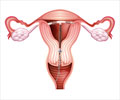New estimates and projections developed for modern contraceptive prevalence (mCPR) to better family planning outcomes in the world's 69 poorest countries.

‘Family Planning 2020 (FP2020) initiative focuses on reaching 120 million users by 2020 in the world's poorest countries.’





They are the focus countries of the Family Planning 2020 (FP2020) initiative, a global partnership that supports the rights of women and girls to decide, freely and for themselves, whether, when and how many children they want to have.The overall goal of FP2020 is to reach 120 million additional users of modern contraceptive methods in the world’s poorest countries by 2020, the "120×20 goal."
The authors report that in 2017, the mCPR among women of reproductive age who are married or in a union in FP2020 focus countries was 45.7 percent, while unmet need for modern methods was 21.6 percent and the demand satisfied with modern methods was 67.9 percent.
At the regional level, Asia has seen the mCPR among women of reproductive age who are married or in a union grow from 51 to 51.8 percent over the period, "which is slow growth, particularly when compared with a change from 23.9 percent to 28.5 percent across Africa," they add.
For this work, Alkema, an assistant professor at the School of Public Health and Health Sciences, with Cahill and Wei there and collaborators from Avenir Health and the Bill & Melinda Gates Foundation, updated their Family Planning Estimation Tool (FPET) to assess current levels of family planning indicators among women of reproductive age who are married or in a union, and changes between 2012 and 2017.
Advertisement
"Country success stories include rapid increases in Kenya, Mozambique, Malawi, Lesotho, Sierra Leone, Liberia and Chad, as compared to what was expected" the researchers write.
Advertisement
The researchers measured mCPR as the percentage of women who report themselves or their partners as currently using at least one modern contraceptive method. They define unmet need for modern methods as the percentage of women who want to stop or delay having a child but who are not currently using a modern method of contraception.
Demand satisfied with modern methods is the proportion of women who want to stop or delay having a child and use a modern method of contraception.
The authors report that between 2012 and 2017 the number of women of reproductive age who are married or in a union who use modern methods increased by 28.8 million.
Alkema and colleagues conclude that while "the estimate of additional users up to 2017 for women of reproductive age who are married or in a union would suggest that the 120×20 goal for all women is overly ambitious, the aggregate outcomes mask the diversity in progress at the country level. We identified countries with accelerated progress that provide inspiration and guidance on how to increase the use of family planning and inform future efforts, especially in countries where progress has been poor."
The analysis was carried out for the world’s poorest countries, which are the focus countries of the FP2020 initiative.
The FP2020 initiative is an outcome of the 2012 London Summit on Family Planning, where more than 20 national governments made commitments to address the policy, financing, delivery of and socio-cultural barriers to women accessing contraceptive information, services and supplies.
Donors pledged $2.6 billion in funding.
Source-Eurekalert










